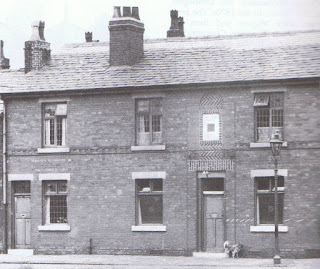Follow @LostPubsBolton
The Lord Hill stood at number 48 Sidney Street, on
the corner of Maxfield Street and in between Bridgeman Street and Lever Street.
The pub was founded in the middle of the 19th
century by John Winward. Originally from York Street, which was the next street
along from Sidney Street, John was a weaver. In January 1840, he married Mary
Partington from Nine Houses – later Ninehouse Lane – and by the time of the
1841 census the couple were living in Sidney Street.
As often happened at that time, the couple decided
to pay the fee of 2 guineas (£2.10) to enable them to open their home as a
beerhouse and they named the premises the Lord Hill.
John Winward remained at the Lord Hill until the
early-1870s. Two events no doubt had a bearing on his decision to quit the pub.
His wife, Mary, died in March 1869 at the age of 54. But in November of the following
year, John Winward married again – this time to Betty Winward, his sister-in-law.
Betty had married John’s brother William Winward in 1840, but she became a
widow on William’s death in 1848 and hadn’t remarried in the intervening 22
years. Within a few years John, now in his sixties, had left the Lord Hill. He
died in 1881.
The pub, which had by now expanded into the premises
next door, was sold to Ellis Crompton of Crompton’s brewery on Derby Street. The
Derby Street Brewery is perhaps Bolton’s forgotten brewery as information on it
is so difficult to find. It was founded by George Pickering in the late-1820s
and the front of the premises was just a few doors up from the Derby Arms. Initially
a retail brewery it changed ownership on a number of occasions. William Maude
was the owner by 1836, by 1853 it was in the hands of William Young and by 1876
it was owned by Ellis Crompton. But it was never a large brewery. Compare it to
Magee’s, which was taking shape on a much larger scale further up Derby Street,
and it gives you an idea of the battle Ellis Crompton faced. The Derby Street
Brewery was tiny by comparison and when brewers began to build up their tied
estates economies of scale ensured his operation was at a financial disadvantage.
Magees, Atkinson’s, Sharman’s and Tong’s were large enough to snap up pubs all
over Bolton. We have only ever come across the Lord Hill as a Derby Street
Brewery pub (though that’s not to say there weren’t a few more). By the
early-1890 the brewery had closed down and the premises were used for a number
of years by Barlow Stores Ltd, an Atherton-based chain of grocery stores.
There were no fewer than four different owners of
the Lord Hill in the 1890s. When Ellis Crompton wrapped up the Derby Street
Brewery the pub was sold to Atkinson’s, a local concern not too far away from
the Derby Street Brewery in Commission Street. But there were new owners again
in 1895 when Atkinson’s sold out to Boardman United Breweries and just three
years after that Boardman’s were taken over by another Manchester brewery,
Cornbrook’s.
The Lord Hill lasted until 1951 and it was a
Cornbrook pub when it closed. By then the writing was on the wall for much of
the area between Bridgeman Street and Lever Street but the Lord Hill was one of
the earliest closures. Pubs like the New Inn, the York Street Tavern and the Peel’s Arms lasted a few years longer. The General Havelock lasted until the eighties.


















